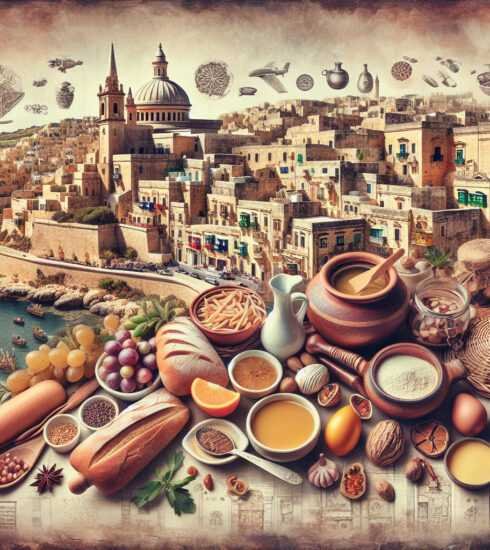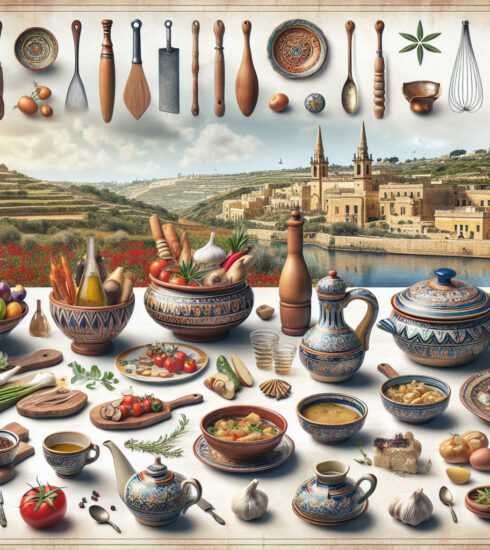Unearthing Maltese Food Legends: Exploring Ancient Recipes and Culinary Tales | Fascinating Article
Introduction
Maltese cuisine is a rich tapestry of ancient traditions, local ingredients, and fascinating culinary tales. With a history dating back thousands of years, the island of Malta has been marinated in a melting pot of cultures, resulting in a unique gastronomic heritage. From the tantalizing tastes of rabbit stew and pastizzi to the delicate nuance of ftira bread and widow’s soup, Maltese dishes are a reflection of the island’s vibrant history and cultural diversity.
In this article, we will delve deep into the ancient recipes and culinary tales of Malta, unearthing the food legends that have shaped the Maltese cuisine we know today. Join us on a journey through time and taste buds as we explore the fascinating flavors and captivating stories behind some of Malta’s most iconic dishes.
The History of Maltese Cuisine
The history of Maltese cuisine is as rich and diverse as the culture and heritage of the island itself. Over the centuries, Malta has been occupied by various civilizations, including the Phoenicians, Romans, Arabs, Normans, Knights of St. John, and the British. Each of these influences has left its mark on the island’s culinary traditions, resulting in a vibrant and eclectic cuisine.
Maltese cuisine is deeply rooted in Mediterranean flavors and ingredients. The island’s fertile soil and favorable climate provide an abundance of fresh produce, including olives, tomatoes, capers, peppers, and fruits. Seafood also plays an important role in Maltese cuisine, with dishes like lampuki (dolphin fish) pie and octopus stew being popular delicacies.
The culinary traditions of Maltese cuisine have been passed down through generations, with recipes often remaining unchanged for centuries. Many dishes have strong ties to the island’s rural history, with ingredients and techniques that have been used for generations. The Maltese have a deep respect for their culinary heritage, and traditional recipes are treasured and celebrated to this day.
The Influence of Arab and North African Cuisine
One of the most significant influences on Maltese cuisine comes from Arab and North African traditions. During the Arab rule of Malta from the 9th to the 11th centuries, the island’s culinary landscape was forever transformed. Arab immigrants brought with them a rich tapestry of flavors and spices, which found their way into Maltese cooking.
Today, many Maltese dishes are flavored with spices such as cinnamon, cloves, turmeric, and saffron, reminiscent of the culinary traditions of the Arab world. Classic Maltese dishes like widow’s soup, which is made with lentils, tomatoes, onions, and spices, clearly showcase these Arab influences.
- Internal Link: An article about Maltese Fusion Cuisine
- Internal Link: An article about Maltese Cuisine
Another staple of Maltese cuisine, pastizzi, showcases the influence of both Arab and North African culinary traditions. Pastizzi are flaky pastries filled with either ricotta cheese or mushy peas. The pastry itself is reminiscent of Middle Eastern and North African pastries such as the Moroccan b’stilla and the Arab sambousek, highlighting the shared culinary heritage of the region.
The Influence of Sicilian and Italian Cuisine
The proximity of Malta to Sicily and Italy has also had a significant impact on the island’s culinary traditions. Over the centuries, there has been a constant exchange of culinary ideas and ingredients between Malta and Sicily. This cross-pollination has resulted in a fusion of Maltese and Italian flavors, creating a unique subset of Maltese cuisine.

Italian culinary traditions, such as pasta and pizza, have become an integral part of Maltese cuisine. Traditional Maltese dishes like timpana, a baked pasta dish with layers of pasta, Bolognese sauce, eggs, and cheese, clearly showcase the influence of Italian cooking techniques and flavors. The use of tomato sauce, basil, and Parmesan cheese in many Maltese dishes also reflects this Italian influence.
The Influence of British Cuisine
From 1800 to 1964, Malta was under British rule, and the British influence on Maltese cuisine cannot be ignored. While British culinary traditions may not be as prevalent in Maltese cuisine as Arab or Italian influences, there are still some notable British-inspired dishes.
One such dish is rabbit stew, known as “laham fuq il-fwar” in Maltese. Rabbit stew has been a staple of Maltese cuisine for centuries and is often considered a national dish. The British introduced the practice of hunting and cooking rabbits during their time in Malta, and the dish has remained a beloved favorite ever since.
Ancient Maltese Recipes
To truly understand the depth and richness of Maltese cuisine, it is essential to explore the ancient recipes that have stood the test of time. These recipes offer a glimpse into the culinary traditions of the past and provide a unique insight into the flavors and techniques that have shaped Maltese cuisine.
Timpana: A Taste of the Past
Timpana is a traditional Maltese dish that dates back to the 19th century. It is a baked pasta dish that features layers of macaroni, Bolognese sauce, eggs, and cheese, all encased in a pastry crust. The origins of timpana are believed to be influenced by Italian cuisine, particularly Sicilian pasta dishes such as timballo.
The dish is made by first cooking the pasta al dente and then tossing it in a rich Bolognese sauce. The cooked pasta is then mixed with beaten eggs and grated cheese to create a creamy and luscious filling. The filling is then encased in a crispy pastry crust and baked until golden brown.
Timpana is a dish that requires time and effort to prepare but is well worth the investment. It is a labor of love that showcases the culinary heritage of Malta and the fusion of flavors that make up Maltese cuisine.
Widow’s Soup: A Taste of Simplicity
Widow’s soup, or “soppa tal-armla” in Maltese, is a humble yet comforting dish that has a long history in Malta. The origins of widow’s soup can be traced back to the time when Maltese families relied on simple and affordable ingredients to make hearty meals.
The soup is made with lentils, onions, tomatoes, garlic, and a blend of aromatic spices. The lentils are simmered in a flavorful broth until they are tender and cooked through. The result is a thick and hearty soup that is both nourishing and delicious.
The name “widow’s soup” is said to come from the fact that it was a popular dish among widows who needed to make do with what they had. Despite its simple ingredients, widow’s soup is a favorite among many Maltese people and is often eaten as a main dish during the colder months.

The Rise of Maltese Fusion Cuisine
While traditional Maltese cuisine remains a strong and cherished part of the island’s culinary identity, there is also a growing movement towards fusion cuisine in Malta. The blending of different culinary traditions and flavors has resulted in exciting new dishes that showcase the creativity and innovation of Maltese chefs.
Melqart’s Journey: A Fusion of Flavors
One shining example of Maltese fusion cuisine is the restaurant Melqart’s Journey, located in Valletta. Drawing on traditional Maltese ingredients and flavors, Melqart’s Journey offers a unique dining experience that marries the past with the present.
At Melqart’s Journey, diners can explore a menu that combines traditional Maltese dishes with contemporary techniques and flavors from around the world. From pumpkin gnocchi with rabbit ragù to caramelized figs with ricotta ice cream, each dish is a harmonious blend of tradition and innovation.
Using locally sourced ingredients, Melqart’s Journey celebrates the rich culinary heritage of Malta while embracing the global flavors that have become an integral part of Maltese cuisine.
Internal Link: An article about Maltese Fusion Cuisine
Chef Marvin Gauci: A Pioneer of Maltese Fusion
Chef Marvin Gauci, a pioneer of Maltese fusion cuisine, has been instrumental in pushing the boundaries of traditional Maltese cooking. With a passion for experimentation and a deep respect for his culinary roots, Chef Gauci has created a unique culinary style that blends Maltese flavors with international influences.
Having trained in some of the finest kitchens around the world, including London’s Le Gavroche and The Dorchester, Chef Gauci brings a wealth of experience and expertise to his work. His restaurant, Tarragon, located in St. Paul’s Bay, offers a menu that showcases his inventive and imaginative approach to cooking.
From seared scallops with black pudding and Maltese sausage to pan-roasted lamb loin with a red wine reduction, Chef Gauci’s dishes are a testament to his talent and creativity. Through his innovative approach, he has helped to shape the future of Maltese cuisine and put the island’s culinary scene on the map.
Conclusion
Unearthing the ancient recipes and culinary tales of Malta offers a fascinating glimpse into the rich tapestry of Maltese cuisine. From the Arab and North African influences to the flavors of Sicily and Italy, each dish carries with it the heritage and history of a diverse and vibrant culture.
As the island of Malta continues to evolve and embrace new culinary traditions, the fusion of flavors and techniques becomes an integral part of the culinary landscape. With talented chefs like those at Melqart’s Journey and Tarragon leading the way, Maltese fusion cuisine is pushing boundaries and redefining what it means to be a part of the Maltese gastronomic landscape.
Whether it’s savoring the traditional flavors of rabbit stew and timpana or exploring the innovative creations of Maltese fusion cuisine, a culinary adventure in Malta is sure to delight the senses and leave a lasting impression.






